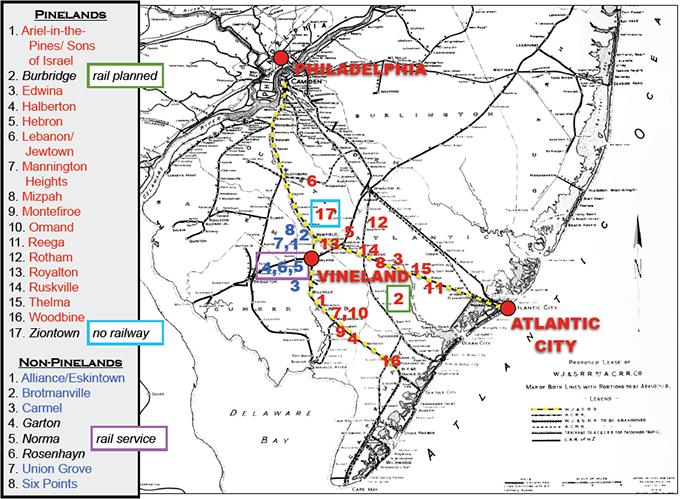 |
|
| Contents | |
| Farming Communities of NJ Homepage |
|
| Alliance, Norma & Brotmanville |
|
| Woodbine | |
| Rosenhayn and Carmel | |
| Roosevelt |
|
| Farmingdale |
|
| After World War II | |
| Synagogues
of Other Farming Communities |
|
| In the News | |
| Resources | |
| Memories | |
| Photos |
|
| JewishGen
Home Page |
|
| KehilaLinks Home Page |
|
|
| Welcome to this website
celebrating the Jewish Farming
Communities of New Jersey
You are invited to contribute your family stories and photos of life in these communities For some Jews, the plight of Jews in Russia was met with an attempt to remake the Jewish condition by re-forging ties to the land that had existed in Biblical times. The Jewish social movement known as Am Olam ( Eternal People ) arose in Odessa, Russia, in 1881, contemporaneous with the onset of the pogroms. Based on the belief that an agricultural life or return to the earth would allow the members of the Jewish diaspora to support themselves and live in community with other Jews. Immigrants from the Am Olam movement immigrated to the United States and continued to foster these principles by creating colonies out west. Immigrants sponsored by the Hebrew Emigrant Aid Society (HEAS) and other aid societies were aware of the idea, if not the reality, of agricultural re-settlement. Beginning in the 1880's, pogroms in Russia caused a large influx of refugees into Galicia. The French Alliance Israelite Universelle (AIU) stepped in to help with housing, food and transportation. Baron Maurice de Hirsch was on the board of the AIU and believed in the colonization of these migrants. The Baron de Hirsch Fund was created to provide immigrants support through relief, temporary aid, land settlement, agricultural training, and trade and general education. The Fund provided loans on real property to Russian and Rumanian refugees and actual agriculturalists already in the United States. It was believed that it was important that only able-bodied candidates for the colonies who were able to pay their own transportation to the US could succeed. In addition to training on agricultural methods, the immigrants were taught English and the duties of American citizenship. Assimilation was a goal. The American Reform movement had the progressive view that relief should be provided to those in a form to provide for their productiveness, proving that the Jewish community was capable of leading productive lives. Early farming communities, such as Alliance(1882) and Woodbine(1891), became a laboratory for those that followed. The map below shows the early Jewish farming colonies.  Map displayed with the permission of Dr Mark Demitroff from his lecture series, Come Earnest Homeseekers: Ethnic Settlements in the Pines. Published by Foster JW, Craig RW, Ogden KN (eds.) Down Jersey: A Guidebook for the Annual Conference of the Vernacular Architecture Forum Conference, Galloway, NJ, May 2014, p. 58. While the Baron de Hirsch Fund was not the only organization that assisted in creating the agricultural communities, Settlements that lacked the external organizational and philanthropic support appeared doomed to collapse. This was true of several attempts by private investors:
Jewish agricultural colonists were also pioneers in Kansas, the Dakota territory, Iowa, Michigan, Colorado, California, Texas, Washington, Louisiana and Oregon. By 1925, the Jewish Agricultural Society (JAS) reported that New Jersey colonies are the only survivors. The Jewish Agricultural (and Industrial Assistance) Society was created by the Fund for the major agricultural effort consisted of making loans to farmers and providing agricultural instruction. Because of the failures of early large scale group settlements, the JAIAS focused on settling individual families on abandoned farms near metropolitan areas. Individual farming seemed to prosper where earlier efforts at group colonization had failed. The JAIAS provided loans to thousands of Jewish farmers and advised them on how to farm by sending out experts and published for fifty years a magazine called the Jewish Farmer. In 1910 there were about 5000 Jewish farm families dispersed in southern New Jersey. By the early 1920’s, the number of farms in the area had doubled as some post World War I immigration from Eastern Europe had resumed. These farms thrived for one or two generations, but nearly all had died out by the 1960s and 1970s. Big factory farms had taken hold, pushing out the smaller farmers. And by then, growing numbers of younger Jews had found easier and more lucrative ways to earn livelihoods in cities. In New Jersey, pioneering Jewish poultry farmers could be found in such areas as Vineland, Toms River, Lakewood and Farmingdale. Poultry farming could support a family without requiring costly manufacturing subsidies. A good deal of these family farms failed during the depression years. The ones that remained or got into farming around 1940 thrived during World War II with the high demand for eggs and other products. Jewish farmers accounted for about 75 percent of New Jersey’s total egg production during the peak years in the 1950s. Jersey Homesteads (Roosevelt) was created under a depression-era United States governmental program. The South Jersey Jewish colonies that not only transformed New Jersey into the Garden State but also served as a model for the development of Israel. Note:
This site is not intended to be a
comprehensive study of these communities,
which has been done by several academics,
but is an overview intending to provide
some insight into life in these Jewish
farming communities.
|